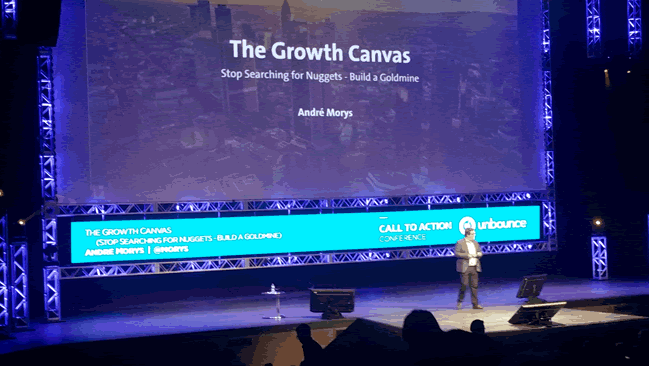DISCLAIMER: This post is written as a live blog from the Call To Action Conference 2016. There may be typos and grammar to make my high school English teachers weep. Please excuse those … it’s a fast=paced conference with back-to-back sessions and no time for proofing or even proper writing.
Andre Morys takes the stage at Unbounce’s Call To Action Conference 2016. He starts with an image trick to illustrate how our minds are working and recognizing patterns.

He talks about the need to see through the data or the mining process (for data) will stop. If you want to scale a web project you need to see the picture though a sea of data. This is no less true in landing page development and understanding how to read the conversion and engagement data. My mocks Dell for their poor checkout process as a company that did not do the job properly. From horrible forms to discussing problems with delivery and credit card fraud right above the contract information.
Then he talks about Booking.com who starts the process with a congratulations for finding the cheapest rate. They then constantly visually reward their users for answering the simplest questions like their name.
Because he manages a 15 billion Euro portfolio in paid search he’s well acquainted with landing page and user process motivating. He brings up reducing friction as the key conversion tool. He also talks about the importance of motivating. Motivate the user and reduce friction in buying.
Stores spend millions of dollars a year analyzing how people move through stores, what draws their attention, etc. We don’t. We forget that conversion are people and this is what the cycle looks like:

He brings up the marshmellow test:
Children that held out were more successful later in life. What was learned however further is that instant gratification produces dopamine which reacts similarly to crystal meth in the brain. Facebook is used as the example of a company that does this well providing minor rewards to the brain constantly. Drawing us to click and be rewarded.
First – ask what problem you’re solving
Then ask – what’s the REAL problem
The problem being solved with a car is transportation but a luxury car is sold more based on implicit problem solving … status.
Amazon Prime increases Amazon sales. Once you’ve paid the $40 to be a member you’ll buy everything just like eating at a buffet. This is base on cognitive bias. You think it’s a better deal simply because you’re already given them your money. An interesting list of all the documented cognitive bias can be found at https://en.wikipedia.org/wiki/List_of_cognitive_biases.
When thinking of landing page testing remember that if you double your tests you’ll double your inventiveness.
He then brings up Booking.com’s brilliant use of scarcity. “The last ticket was sold …”
The Ashe experiments show that group pressure motivates highly. Booking.com thus shows what people are doing on their site to help use this to motivate others to conform.
Andre them moves on to pressure marketers to put match and data to ideas. We need to convince clients and C’Level of our ideas and to do this we should be able to show metrics on how these changes compound on each other to produce exponential growth.
